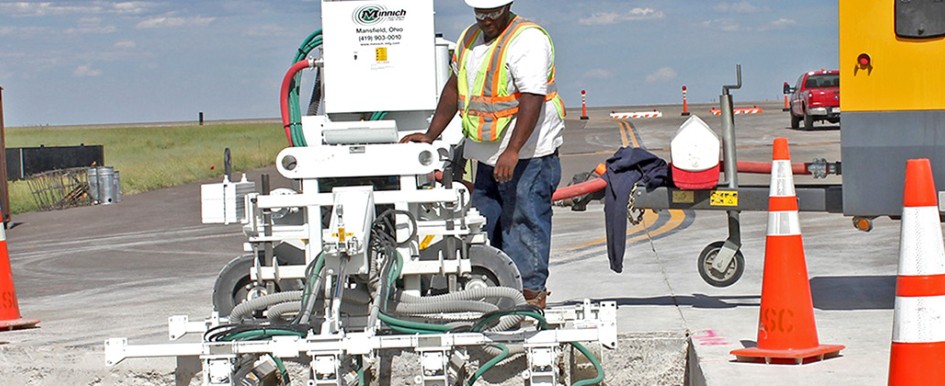
Highway construction projects are multifaceted challenges for contractors. One component that is critical to staying on schedule and under budget is dowel pin drilling.
To help keep road projects moving, contractors must select the proper dowel pin drill for the job, maximize safe, efficient operation and diligently follow maintenance recommendations and regulations. The following are four best practices for road contractors.
1. Choose drills wisely
Neglecting to right-size the dowel pin drill and compressor for the job can lead to inefficiency, maintenance issues and equipment downtime. When selecting a dowel pin drill, contractors should consider the project type, the number of holes required and any compressed air needs.
For larger road construction projects where long stretches of concrete need to be drilled, contractors should consider multigang, on-slab, dowel pin drills. Some drill manufacturers offer self-propelled wireless units that maximize drilling efficiency, accuracy and safety.
Wireless, remote control technology enables operators to drill up to five holes at once and drive down the slab to drill the next set of holes—all while standing in the grade, away from the equipment. From this vantage point, operators can drill faster and more accurately while avoiding dust, debris and obstacles.
Power crab steering can further boost efficiency by letting operators drive down the slab without continually raising and lowering the drill bed. If a multigang, self-propelled, wireless drill offers too much drill for a job, a money-saving alternative may be a dual pneumatic push unit with steering capabilities.
For full-depth repair or “patchwork” jobs in which sections of concrete need to be removed and replaced, contractors should consider drills that can be mounted to an excavator or backhoe. Available in both hydraulic and pneumatic options, these drills offer superior portability and eliminate operator fatigue by utilizing the carrier to transport the drill. There are many other drill models and configurations available.
A dowel pin drill dealer can help contractors obtain precisely the right drilling solution for their project. In some cases, a customized drill may be an option for added productivity on the jobsite.
2. Obey the operator’s manual
Proper dowel pin drill operation helps contractors maximize efficiency, drill uptime and operator safety. Operators should thoroughly read the manual for their specific drill and use the machine according to the listed instructions. Operator’s manual requirements vary from manufacturer to manufacturer and from drill to drill. Some operation tips include:
- Use all appropriate safety equipment, including hearing and eye protection.
- Make sure the air line is cleaned out and is the proper size and pressure rating for the drill unit.
- Approximate the number of bits needed with usage calculations formulas found in the operator’s manual. Calculations could vary depending on the hardness of the concrete, the aggregates used and the possibility of bits hitting steel reinforcement.
- Minimize the frequency of dry firing, which can lead to increased maintenance and repair costs.
3. Be married to maintenance
Proper maintenance is key to maximizing dowel pin drill efficiency and uptime and minimizing costs, so it is crucial for contractors to follow the maintenance guidelines detailed in the operator’s manual. Lubrication is one of the most important maintenance items. Contractors should lubricate the equipment at the appropriate intervals with the correct lubricants to avoid overheating, excessive wear and damage.
Maintenance personnel should fill lubricators at the suggested hour intervals, using only the recommended lubricants. Intervals and a list of acceptable lubricants for defined ambient temperature ranges can be located in the drill’s operator’s manual. Additional regular maintenance items include:
- Thoroughly inspect the machine to ensure excellent condition.
- Check all hardware for tightness daily and tighten as needed.
- Grease all fittings at least once a week.
It is important to note that these are general guidelines from one dowel pin drill manufacturer. Contractors should always adhere to maintenance procedures in the manual for their specific drill.
4. Start collecting dust
OSHA’s final silica rule for dust exposure is a hot topic throughout the construction industry. The new rule requires that construction employers limit worker exposure to respirable crystalline silica in construction activities. Employers covered by the standard basically have two alternatives to satisfy the rule’s requirements:
- Measure worker exposure to silica and independently determine which dust controls work best to reduce exposure to the new permissible exposure limit (PEL). Exposure measurements can be expensive and time-consuming to perform.
- Use a dust-control approach outlined in OSHA’s “Table 1: Specific Exposure Control Methods When Working with Materials Containing Crystalline Silica,” available at www.osha.gov/silica. Table 1 lists effective dust-control methods and work practices that can be used to meet the requirements of the new rule.
Table 1 states that, for tasks performed outdoors only, dowel pin drill operators can comply by using a shroud around the drill bit with a dust collection system. The dust collector must have a filter with 99 percent or greater efficiency and a filter-cleaning mechanism. According to the Table 1 section on dowel drilling, workers must also use a respirator with an assigned protection factor (APF) of at least 10. A HEPA-filtered vacuum must be used when cleaning holes.
The construction industry’s silica rule compliance date is scheduled for June 23, 2017. Contractors should continue to plan ahead and, if choosing to pursue the Table 1 alternative, obtain a dust collection system that meets the listed requirements.
By following these tips and connecting with their dowel pin drill dealer, contractors can ensure that the dowel pin drilling component of their projects runs smoothly.



